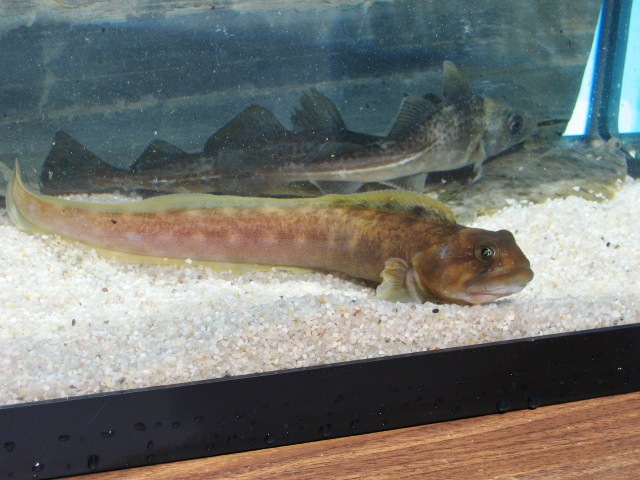Ocean Pout

Scientific Name: Macrozoarces americanus
Description: Elongate eel like body with a broad head, blunt snout and large fleshy lips. Colour ranges from muddy yellow to reddish brown, mottled with grey or olive green.
Distribution: Common along the western Atlantic Ocean coast from the northern waters of Newfoundland down to the coast of Delaware.
Diet: Ocean pouts feed by scooping up mouthfuls of sediment and extracting the food. They consume marine worms, sea urchins, brittle stars, crabs, shrimp amphipods, welks and many other molluscs.
Growth: Growth is slow in species. Ocean pouts reach a length of 31 cm in five years and ~65 cm in 16-18 years.
Reproduction: Spawning occurs in crevices and holes under boulders from late August to September depending on the region. Eggs are laid all at once in gelatinous masses, about 130-4200 eggs depending on the size of the female. She guards them until they hatch two to three months after fertilization. During this time, the female reduces feeding, but resumes it after the eggs hatch.
Predation: The young are very susceptible to predation and are eaten by skates, sculpins, sea ravens, cod and harbour seals.
Relation to man: There is no fishery for this fish in Canadian waters, although it is a potential species for aquaculture due to its meaty tail and leathery skin. Ocean pouts are also used extensively in physiological studies, skeletal muscle and antifreeze protein research.
Images
 |
 |
||
OSC Research
Fletcher Lab - The diversity, evolution, mechanisms of action, and physiological regulation of fish antifreeze proteins and their genes - The subzero water temperatures and ice that characterise the coastal waters of Newfoundland and other polar and subpolar regions of the world during winter are lethal to most teleost fishes. The only teleosts that survive such environments are those that produce antifreeze proteins. Research at the OSC in collaboration with C. Hew (National University of Singapore) and P. Davies (Queen’s) has, and is being carried out on all aspects of these unique proteins: molecular biology, fisheries oceanography, transgenic fish, and commercialisation of some of the findings.